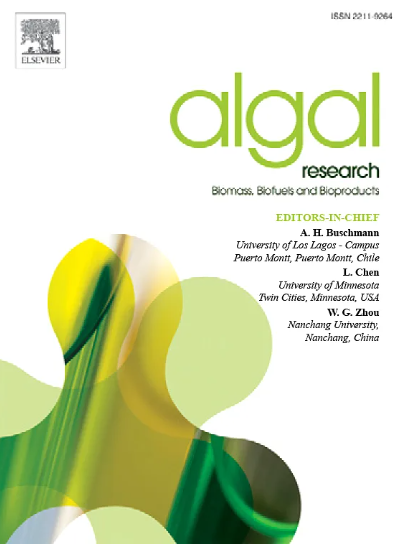微藻相关嗜麦芽窄养单胞菌提高单胞菌叶黄素产量和生物刺激素活性。
IF 4.5
2区 生物学
Q1 BIOTECHNOLOGY & APPLIED MICROBIOLOGY
Algal Research-Biomass Biofuels and Bioproducts
Pub Date : 2025-07-29
DOI:10.1016/j.algal.2025.104250
引用次数: 0
摘要
像微藻这样的光合生物可以收集太阳能并将其转化为生化化合物,作为其他形式的能量,可以在代谢过程中利用。在自然界中,微藻与细菌群落共存,可能保持共生关系。在目前的研究中,从一种适应冷的绿色微藻单胞菌(Monoraphidium sp.)的藻球中分离出一种异养细菌,嗜麦芽寡养单胞菌。采用先进的液相色谱-高分辨率串联质谱(LC-HRMS/MS)技术,检测了由嗜麦芽葡萄球菌产生的高丝氨酸内酯(HSLs): 3OHC12-HSL、3OHC10-HSL、3OHC14-HSL、C10-HSL、C8-HSL和OC14-HSL。此外,还评价了该细菌在建立复杂关系中的作用及其在生物技术潜力方面的意义。与对照组的13.7±1.87 mg g - 1 DW相比,细菌补充剂显著提高了单芽甘蓝培养物的叶黄素产量,达到约19.3±0.88 mg g - 1 DW,增加了约40%。此外,还通过番茄和大麦种子的萌发试验,评价了单孢菊的生物刺激素潜能。与对照相比,番茄和大麦的发芽率分别提高了55%和110%,这与微藻的生长阶段有关。在与微藻培养的复杂关系如何影响其生物技术潜力(例如,生物刺激素活性和叶黄素生产)方面,对细菌的作用进行了评估。目前的工作扩展了我们在设计基于互补特性和代谢潜力的高效混交培养方面的知识,以最大限度地提高藻类生物技术的产量和生物活性。本文章由计算机程序翻译,如有差异,请以英文原文为准。

Microalgae-associated Stenotrophomonas maltophilia enhances lutein production and biostimulant activity in Monoraphidium sp.
Photosynthetic organisms like microalgae can collect solar energy and transform it into biochemical compounds as other forms of energy that can be utilized in metabolic processes. In nature, microalgae coexist with bacterial communities and may maintain a symbiotic relationship. In the current study, a heterotrophic bacterium, Stenotrophomonas maltophilia was isolated from the phycosphere of a cold-adapted green microalga Monoraphidium sp. (further abbreviated as Monoraphidium). By using advanced liquid chromatography-high-resolution tandem mass spectrometry (LC-HRMS/MS), we were able to detect homoserine lactones (HSLs): 3OHC12-HSL, 3OHC10-HSL, 3OHC14-HSL, C10-HSL, C8-HSL, and OC14-HSL, produced by S. maltophilia. Further, the role of this bacterium in establishing intricate relationships and its implication on biotechnological potential was evaluated. Significant improvements were found in the lutein production of the Monoraphidium culture with bacterial supplements, achieving about 19.3 ± 0.88 mg g−1 DW of this carotenoid compared to 13.7 ± 1.87 mg g−1 DW in the control, which represents an increase of about 40 %. Furthermore, the biostimulant potential of Monoraphidium was evaluated using the germination tests with tomato and barley seeds. A higher germination index was observed with improvements of 55 % in tomato and 110 % in barley, respectively, as compared to the control culture, which was related to the microalgae's growth stage. The role of the bacterium was evaluated in how the intricate relationships with the microalgal culture can affect its biotechnological potential (e.g., biostimulant activity and lutein production). The current work expands our knowledge towards designing an efficient polyculture based on complementary traits and metabolic potential to maximize the yield and bioactivity in algal biotechnology.
求助全文
通过发布文献求助,成功后即可免费获取论文全文。
去求助
来源期刊

Algal Research-Biomass Biofuels and Bioproducts
BIOTECHNOLOGY & APPLIED MICROBIOLOGY-
CiteScore
9.40
自引率
7.80%
发文量
332
期刊介绍:
Algal Research is an international phycology journal covering all areas of emerging technologies in algae biology, biomass production, cultivation, harvesting, extraction, bioproducts, biorefinery, engineering, and econometrics. Algae is defined to include cyanobacteria, microalgae, and protists and symbionts of interest in biotechnology. The journal publishes original research and reviews for the following scope: algal biology, including but not exclusive to: phylogeny, biodiversity, molecular traits, metabolic regulation, and genetic engineering, algal cultivation, e.g. phototrophic systems, heterotrophic systems, and mixotrophic systems, algal harvesting and extraction systems, biotechnology to convert algal biomass and components into biofuels and bioproducts, e.g., nutraceuticals, pharmaceuticals, animal feed, plastics, etc. algal products and their economic assessment
 求助内容:
求助内容: 应助结果提醒方式:
应助结果提醒方式:


